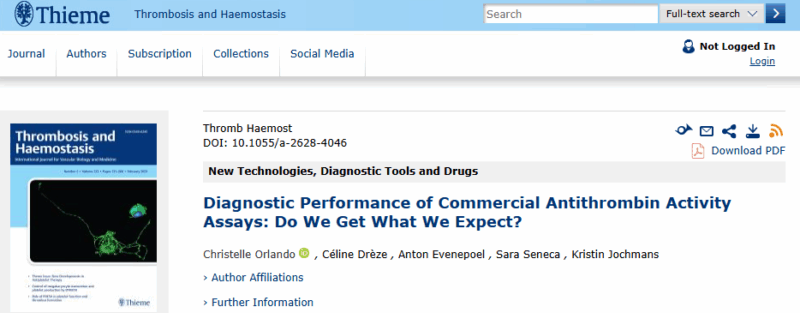
Christelle Orlando: Type II Antithrombin Deficiency Frequently Underdiagnosed Due to Assay Limitations
Christelle Orlando, Coagulation Lab Expert at UZ Brussel and Vrije University Brussel, has shared a post on LinkedIn:
“New publication alert
I’m proud to present our recent paper on diagnosis on inherited antithrombin deficiency, published in Thrombosis and Haemostasis.
Diagnostic performance of commercial antithrombin activity assays: do we get what we expect?
In this paper, we compared the most commonly used antithrombin (AT) activity assays in their ability to diagnose inherited antithrombin deficiency, with a focus on type II AT deficiencies.
Key findings:
- Sensitive commercial AT activity assays are mandatory to identify AT deficiency
- Diagnostic sensitivity of commercial AT assays varies widely
- Some commercial AT activity assays are not suited for diagnosis of AT deficiency
- We report the first method comparison data from AT activity assays performed on CN6000 and sthemO301
- We describe two novel SERPINC1 variants responsible for type II AT deficiency
Take home messages:
This study highlights the poor performance of commercial antithrombin activity assays in their ability to detect type II AT deficiency. Our results suggest that this subtype of AT deficiency, a severe thrombotic disorder, is underdiagnosed.”
Title: Diagnostic Performance of Commercial Antithrombin Activity Assays: Do We Get What We Expect?
Authors: Christelle Orlando, Céline Drèze, Anton Evenepoel, Sara Seneca, Kristin Jochmans

Read the full paper here.
Stay updated with Hemostasis Today.
-
Oct 28, 2025, 14:27Maha Othman on 10-Year Anniversary of the CanVECTOR Research Network!
-
Oct 28, 2025, 14:00Claudio Laudani on PCSK9 Association with Increased Platelet Reactivity: A Pooled Analysis
-
Oct 28, 2025, 13:31Laurent Bertoletti Invites You to The INNOVTE and GITA Joined Meeting on Hormones and Thrombosis
-
Oct 28, 2025, 12:28Courtney Lawrence: Honored to Team Up with BET on Blood at AABB 2025
-
Oct 27, 2025, 19:45Benedikt Lorenz on Liver Failure and Coagulation – Myths, Traps, and Bad Habits
-
Oct 28, 2025, 13:09Gregory Piazza on CORONA-VTE Network Analysis
-
Oct 27, 2025, 18:42Khaled Musallam Shares BEYOND Trial Phase 2 Insights on Luspatercept Use in NTD β-Thalassaemia
-
Oct 27, 2025, 13:30Fabrice Cognasse: When Platelets Meet Artificial Intelligence!
-
Oct 27, 2025, 13:00Hossam El Benawi Shares Multi Site LVT Study from Mayo Clinic
-
Oct 27, 2025, 08:01Acquired Hemophilia A (AHA) is Rare and Often Missed - RPTH Journal
-
Oct 25, 2025, 07:42Adithya Hande: India’s Silent Killer and a Scientific Breakthrough
-
Oct 23, 2025, 09:57Arun V. J: Artificial Blood Is Closer Than You Think
-
Oct 23, 2025, 07:11Sebastien Lobet Presented the ACTIVLIM-Hemo Scale
-
Oct 23, 2025, 07:05Syed Ehsan Shah on Advantages of Werfen HemoCell Automation
-
Oct 22, 2025, 08:25Johanna Nystedt: Not Every Day We Can Release a New Blood Product to Meet An Unmet Medical Need!
-
Oct 27, 2025, 15:10David McIntosh: Making Measurable Progress – Towards a World in Which No-one Ever Dies from Lack of a Vital Plasma-Derived Medicine
-
Oct 27, 2025, 13:18Stroke Foundation Welcomes Jacqui McCallum as the New Executive Director
-
Oct 27, 2025, 12:54Guillermo Lahera Forteza on Stroke and Mental Health
-
Oct 27, 2025, 12:37Joshua Ngimbwa Recognised as the Best Male Junior Investigator Awardee at the Tanzania Health Summit
-
Oct 27, 2025, 08:00Rohit Gosain: Revumenib is Now FDA Approved for R/R AML with NPM1 Mutation
